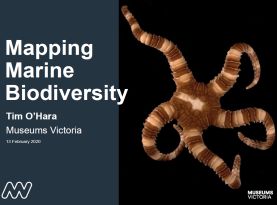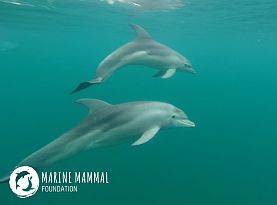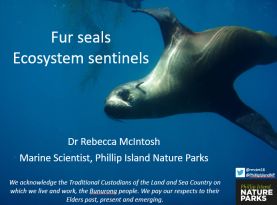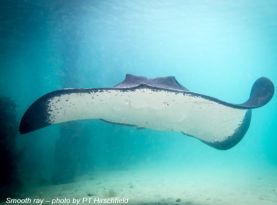SWIFFT Seminar notes 13 February 2020
Marine biodiversity
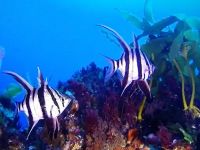
SWIFFT seminar notes are a summary of the seminar and not intended to be a definitive record of presentations made and issues discussed.
This SWIFFT seminar was conducted via Zoom and supported through resources and technology provided by the Department of Environment, Land, Water and Planning, Victoria. SWIFFT wishes to thank speakers for their time and delivery of presentations. Thanks to Andrew Geschke who acknowledged traditional owners and chaired the session from Arthur Rylah Institute, Heidelberg.
Key points summary
- The deep sea where depths are 4 km or deeper covers 50% of the planet.
- Australian marine fauna is divided up into tropical and temperate zones which extended down to 2,000 metres deep.
- 2,200 species of Brittle-stars have been identified around the world.
- Over half of the worlds marine species have now been included in the ‘tree of life’ .
- There has been a rise in the exploration of deep sea mining.
- The Marine Mammal Foundation focuses on the marine environment through research, community engagement and conservation.
- The MMF was founded in 2013 following discovery of a new dolphin species (Burrunan dolphin) in Victorian coastal waters.
- Between 2017 – 2020 the Marine Mammal Foundation has delivered 307 Education and Community Outreach programs. It has had direct engagement with over 22,700 community members.
Fur seals - Ecosystem sentinels
- Phillip Island Nature Parks is a not for profit entity with a conservation led management approach.
- During the early 1800’s European colonial sealers over-harvested seals to a point where some species were eliminated from Bass Strait.
- Between 2007 to 2017 there has been a decline in the number of Australian Fur Seal pups.
- Humans impact on seals by causing, entanglements, ingestion of plastics, bioaccumulation of pollutants and climate change.
Balancing community values on rays and banjo sharks
- The Victorian Fisheries Authority worked with all stakeholders to achieve a shared solution regarding rebalancing fishing laws to conserve rays, skates and guitarfish.
-
There is no sustainability issues for any species of rays in Victoria. The program was all about community values and social acceptability.
-
The Fisheries Regulations provide balanced and socially acceptable ray fishing rules that are well understood and accepted by recreational fishers on piers.
List of speakers and topics
- Mapping Marine Biodiversity - Dr Tim O’Hara, Museums Victoria
- Marine Mammal Foundation - Matt Montemurro, education, outreach coordinator, MMF
- Fur seals - Ecosystem sentinels - Dr Rebecca McIntosh, Marine Scientist, Phillip Island Nature Parks
- Balancing community values on rays and banjo sharks in our nearshore waters - Dr Jo Klemke, Senior Policy Analyst, Victorian Fisheries Authority
Mapping Marine Biodiversity
Dr Tim O’Hara, Museums Victoria
Mapping at a global scale
Tim introduced his talk by emphasising the large-scale nature of the project which involves collecting historical records from databases and museums for the preparation of large-scale maps to show where marine animals are in our oceans and in particular the deep sea.
Tim discussed how he focused on one particular group of animals, the Ophiuroidea (brittle-stars) which have widespread dispersal throughout the oceans from the shallow waters to the deep trenches and from Antarctica to the equator.
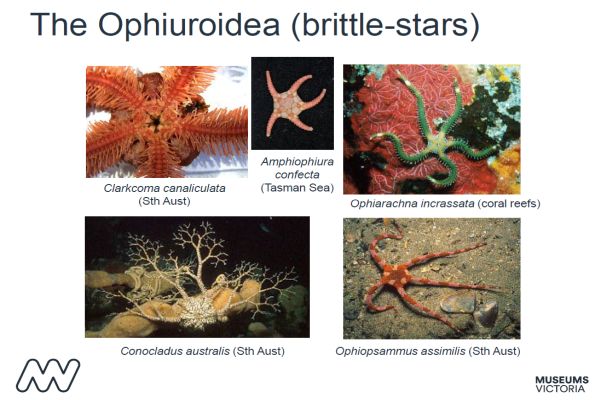
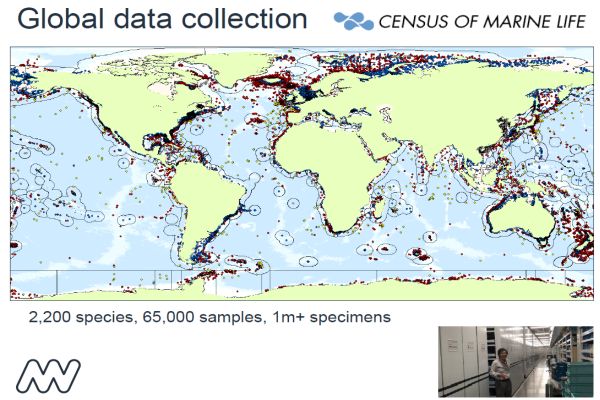
The sea covers 70% of the planet and the deep sea where depths are 4 km or deeper covers 50% of the planet. At present there little understanding of species range limits or dispersal and few biogeographic maps. The current UNESCO (2009) Deep Sea classification 700 to 3000 m depth is based on biophysical surrogates e.g. (productivity / temperature) to predict marine diversity and not based on biodiversity. Tim’s work has been dedicated to including life forms and building a more biogeographic context around the world.
Mapping the continental margin
Tim spoke about some of the marine mapping work undertaken in 2017 along the Australian continental shelf in eastern Australia which included some of the new Marine Parks. Many new animals were discovered for the first time.
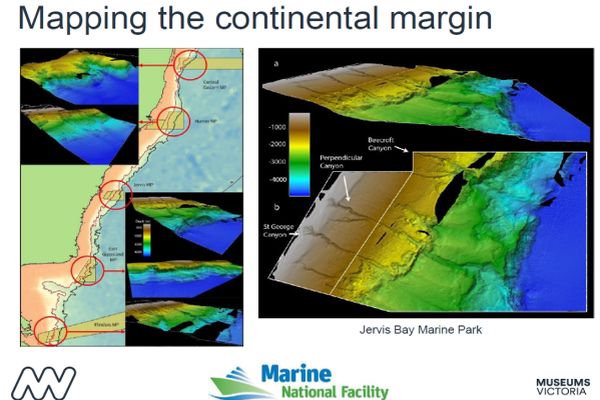
Biogeography
Tim spoke about marine biogeography mapping around Australia. The Australian marine fauna is divided up into tropical and temperate with a transition zone around mid-continent. Whilst this was largely recognised for surface waters Tim’s work found the zones extended down to 2,000 metres deep. Mapping also revealed temperate deep-water species are shared with New Zealand whereas in shallow waters there are more differences.
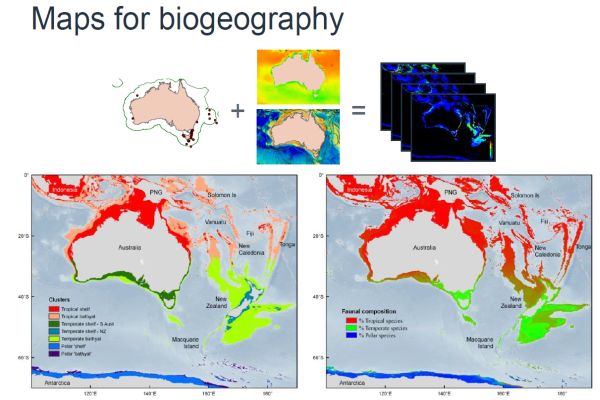
Marine regions
Tim spoke about how the world can be divided up into different marine regions.
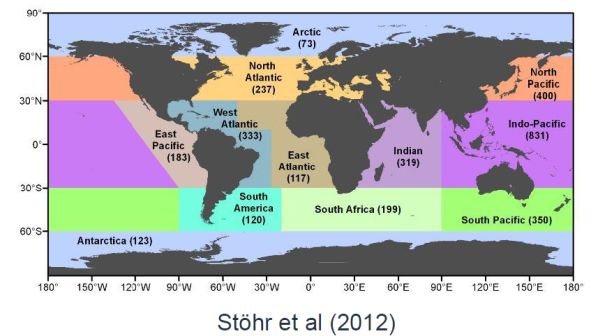
The work Tim has been doing contributes to our understanding of important areas in the deep ocean which could one day help in determining a Global Marine Park system. Mapping areas of species richness includes shallow waters, mid water between 1-3 km deep and very deep water. In shallow water, species richness is higher in the tropics but in deep water species richness is concentrated around areas of high phytoplankton abundance.
Phylogeny (tree of life)
Over half of the worlds marine species have now been included in the ‘tree of life’ which enables science to see species relationships across the globe, where and when the deep-sea fauna originated as well as relationship between the faunal regions.
Tim spoke about a number of graphs from the study area which measured brittle stars species richness by depth and latitude i.e. from 0o Equator to -700 Antarctica by depth, taking a slice through the ocean. The first kilometre of the ocean in tropical waters contains the most species richness which extends to the deeper areas off Tasmania.
Tim discussed the family tree in terms of phylogenetic diversity and ancient linages which has enabled data to be mapped. Most of the ancient linages occur in the tropics between 200m to 800 m deep.
Ocean realms
Tim spoke about two realms which have been identified spanning tropical, temperate and Antarctic waters.; a shallow water set of animals and a deep sea-Antarctic set of animals.
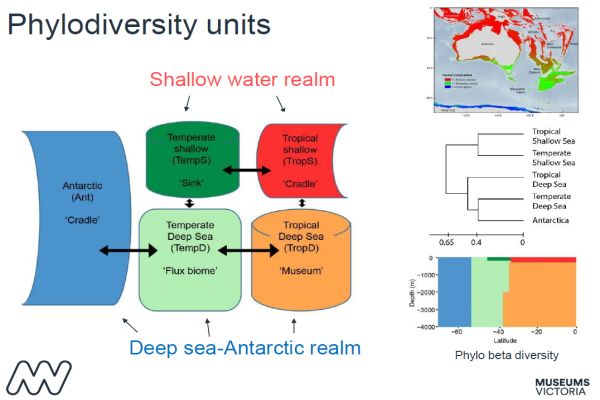
Diversity
The diversity of brittle-star species has been dated from the ‘tree of life’ which dates back to species 270 million years old when the first Brittle-stars lived and diversified over time to the 2,200 species now identified. The rate of species diversification increased from about 50 million years ago and is thought to be associated with a period of global cooling which allowed diversification in Tropic, Temperate and Polar marine fauna.
Protecting special areas from human activities
Tim spoke about a rise in the exploration of deep sea mining. One area between Mexico and Hawaii called the Clarion-Clipperton Zone on the abyssal plain has been identified as having nodules containing high mineral deposits of manganese, nickel and rare earths. Mining leases covering massive areas are being staked out by different countries and companies. The process is managed through the International Seabed Authority (ISA).
Analysis of biological data from the Clarion-Clipperton Zone found a higher number of species than any other abyssal area in the world with three of the new lineages dating back to 70 million years which points to it being a very old environment.
More about the Clarion-Clipperton Zone
Marine spatial planning
Tim spoke about applying species information from maps into a decision support system for management and conservation.
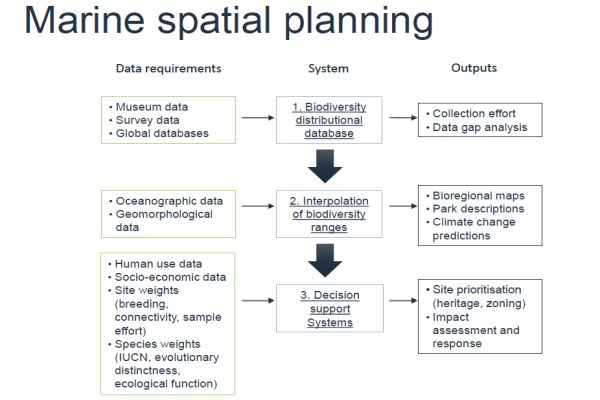
Tim acknowledged collaborators and funding:
Funding sources: NESP Marine Biodiversity Hub, Marine National Facility, Census of Marine Life, INDEEP network of Deep-sea Scientists, Museums Victoria, Muséum National d’Histoire Naturelle.
The laboratory: A. Hugall, A. Weber, K Naughton, S. Woolley (CSIRO), G. Bribiesca-Contreras (NHM).
Tree-of-life tissue samples: Museums Victoria, Muséum National d’Histoire Naturelle, Florida Natural History Museum, National Institute of Water and Atmosphere Wellington, Universidad Nacional Autónoma de México, CSIRO, Californian Academy of Science, National Museum of Nature and Science Tokyo, Museum of Tropical Queensland, South African Museum, Western Australian Museum, Australian Museum Sydney, University of Galway, University of Vigo, Zoological Museum Moscow State University, German Centre for Marine Biodiversity Research Hamburg, Scripps Institution of Oceanography Dan Diego.
Key points from Questions
- There is very limited mapping of species diversity on mid-ocean ridges; hydro-thermal vents support a specialised community but they can disperse from one vent to another as vents collapse and reappear in a new location.
- Ocean acidification can impact on deep-sea corals.
- Many of findings from the research are based on brittle-stars but can be applied to fish, some crustaceans and molluscs.
- Impacts from Climate Change are more likely to impact on temperate zone species. Tropical species can move south but temperate zone species which have evolved over the past 40 million years have nowhere to go as there is no substantive land mass until Antarctica. There is concern that a number of temperate species in southern Tasmania could become extinct.
Marine Mammal Foundation
Matt Montemurro, education, outreach coordinator, Marine Mammal Foundation
Matt provided an introduction to the Marine Mammal Foundation (MMF) which aims to be a leading Australian marine mammal conservation organisation, protecting the marine environment through research, community engagement and conservation. The Marine Mammal Foundation was founded in 2013 by Dr Kate Robb following her discovery of a new dolphin species Tursiops australis (Burrunan dolphin) in Victorian coastal waters.
The MMF is a not-for-profit research, education, and conservation foundation. It conducts robust, internationally recognised research from which findings are used to provide education and raise awareness about the incredible marine life available to us in Victoria and create sustainable conservation outcomes to enhance the natural environment.
A new species of Dolphin
Matt spoke about the fact that many people are not aware of Victoria’s marine mammals, in particular that dolphins live in Port Phillip Bay and the Gippsland Lakes and that a new species of dolphin Tursiops australis Burrunan dolphin was discovery in Victoria in 2011.
Video of Burrunan Dolphin taken by Matt Montemurro, education, outreach coordinator, Marine Mammal Foundation. Images collected under scientific permit and animal ethics approvals. Video subject to copyright and must not be copied without permission from Marine Mammal Foundation.
Matt provided an overview of the process which lead to the discovery of the Burrunan dolphin which included genetics and morphological studies which differentiated it from the Indo-pacific Bottlenose and Common Bottlenose dolphins. Kate published her findings in 2011. Robb et al. (2011) A New Dolphin Species, the Burrunan Dolphin Tursiops australis sp. nov., Endemic to Southern Australian Coastal Waters https://doi.org/10.1371/journal.pone.0024047
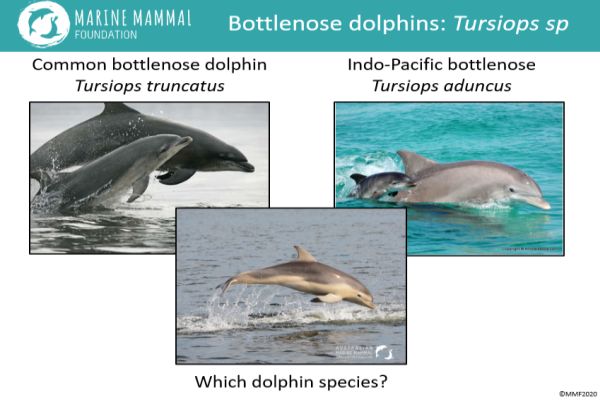
Distribution of Burrunan dolphin
The Burrunan dolphin has limited distribution with small isolated populations and is only known from south-eastern Australia, with a resident population of about 120 Burrunan dolphins in Port Phillip Bay and approximately 65 in the Gippsland Lakes. The Burrunan dolphin has also been sighted at few other locations in Victoria and down the east coast of Tasmania.
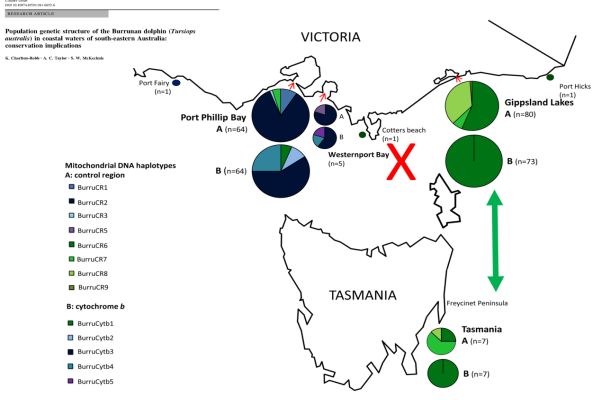
Identifying individual dolphins
Matt spoke about the techniques used to identify dolphins which includes studying the unique markings on the trailing edge of the dolphin’s dorsal fin. Various notches are formed over the life of the dolphin when interacting with each other. Researchers at the Marine Mammal Foundation now know all the dolphins and have been able to identify many of the dolphins dating back to 2006 when they first started the study. They have also identified mothers and new dolphin calves in the population.
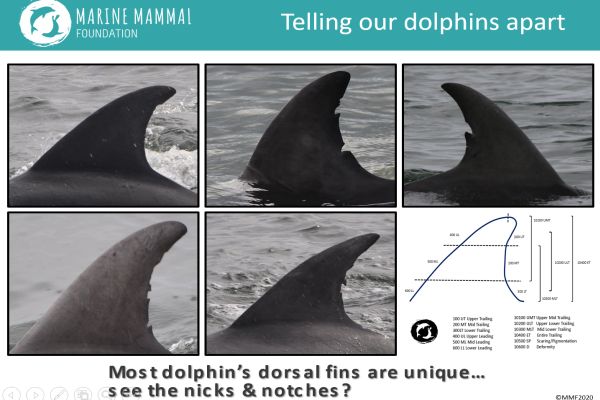
Research
The Marine Mammal Foundation undertakes a range of research programs focused on marine mammals across Victoria.
The MMF has collected a vast amount of data on individual Burrunan dolphins. Information allows the researchers to learn about the movement of dolphins over years and seasons and develop a better understanding of the population and its habitats which can be used for conservation management. The research is also building information about the Burrunan dolphins’ behaviour and complex social networks.
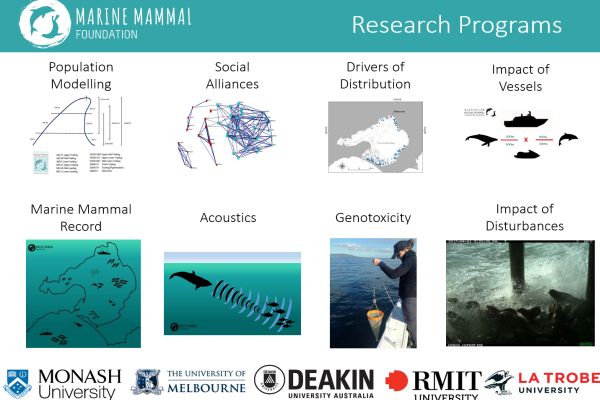
Conservation
The Burrunan dolphin is considered Endangered and is Listed under the Victorian Flora & Fauna Guarantee Act 1988. Matt spoke about human impacts on dolphins and the marine environment caused by litter, entanglements, boat strike and the need to comply with Marine Mammals Regulations concerning keeping safe distance from boats and jet skis.
Education
Matt emphasised the importance of education in delivering conservation outcomes. The philosophy of the Marine Mammal Foundation’s education program:
- Inspire appreciation of marine environments;
- Foster a connection to marine environments through marine mammals;
- Empower positive action;
- MMF employs a wide range of education, community outreach, and citizen science programs;
- Engage all communities and stakeholders;
- MMF is uniquely placed to combine applied research with conservation action.
Marine Mammal Foundation community engagement activities include:
- Community festivals;
- Public presentations;
- Community group workshops;
- Next generation education programs which are curriculum aligned, both primary and secondary levels;
- Citizen Science programs to assist with data collection;
- Marine Champions youth engagement program in Port Phillip and Gippsland Lakes regions;
Matt stressed it is important to connect the community to science, scientists, and volunteers.
Some of the highlights include 307 Education and Community Outreach programs delivered (2017 – 2020). Direct engagement with over 22,700 community members. Participant feedback demonstrates positive benefits of community education and outreach programs.
Key points from Questions
- The Burrunan dolphin utilises the entire Port Phillip Bay for habitat.
- A small number of Burrunan dolphins have been regularly sighted in Westernport Bay. These dolphins may comprise some of the Port Phillip Bay population.
- Mapping clusters of Burrunan dolphin sightings in Port Phillip Bay may assist in developing conservation options.
Fur seals - Ecosystem sentinels
Dr Rebecca McIntosh, Marine Scientist, Phillip Island Nature Parks
Phillip Island Nature Parks is a not for profit local government entity funded mainly through eco-tourism. It has a conservation led management approach supported by:
- Research - threat detection and scientific investigation;
- Management - threat mitigation and habitat restoration;
- Education - education programs, Penguin Parade Rangers, Research;
- Promotion - media and marketing;
- Ecotourism - Income, education, conservation awareness.
Rebecca discussed the two main overarching plans:
Phillip Island Nature Parks (2019). 5-Year Conservation Plan 2019-2023 - pdf
Phillip Island Nature Parks (2019). Beyond the Horizon a 30-Year Conservation Vision - pdf
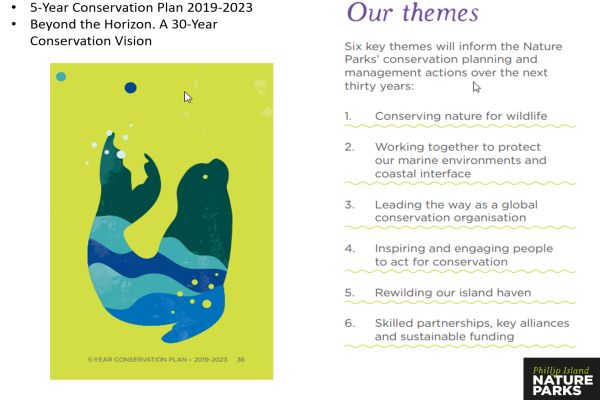
Impacts from early sealing
Rebecca provided an introduction to the concept of marine ecosystem food webs and how everything from the sea floor to the surface is connected and has a role in the ecosystem, but we sometimes overlook our influence on these systems. For example, when European colonial sealers arrived in the early 1800’s they rapidly altered the ecosystem and over-harvested seals to a point where species such as the Elephant Seal, Australian Sea Lion and New Zealand Black fur seal were eliminated from Bass Strait. Also, the Australian Brown Fur seal (est. population 200,000 was close to being wiped out. The rapid removal of these top predators undoubtedly changed the ecosystem and the food web.
Further reading: Russell L (2007) "Dirty Domestics and Worse Cooks": Aboriginal Women's Agency and Domestic Fronteirs, Southern Australia, 1800-1850. Frontiers: A Journal of Women Studies 28:18-46
Australian Fur Seal population trend
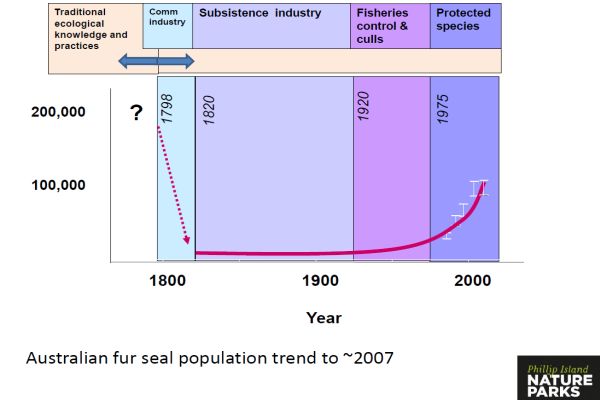
Fur seals as ecosystem sentinels
Rebecca explained why the Australian Fur Seal makes a good sentinel species:
Marine predator, top of the food chain;
Bioaccumulates pollutants via the food chain;
Breeds and defecates on land which enables analysis of scats;
Highly centralised in high numbers enabling counting of pups;
Synchronised annual breeding season helps with monitoring the population.
Distribution
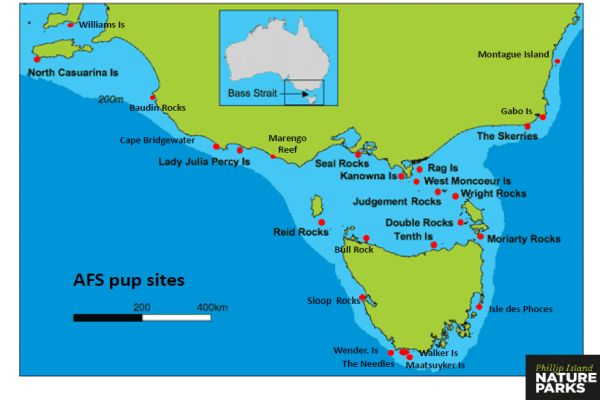
Movement
“Video subject to Copyright: Phillip Island Nature Parks and Macquarie University”
Movement of Australian Fur Seals (females - orange, males- blue). Feeding occurs mainly on the Continental Shelf which means seals from Seal Rocks travel vast distances for feeding.
Source: Salton, M., R. Kirkwood, D. J. Slip and R. Harcourt (2019). "Mechanisms for sex-based segregation in foraging behaviour by a polygynous marine carnivore." Marine Ecology Progress Series 624: 213-226.
Threats
Most of the research work undertaken by Phillip Islands Nature Parks on seals is focused on anthropogenic change (how humans are impacting on the Australian Fur Seal), studies include:
- Foraging ecology and diet;
- Population abundance;
- Fur seal health;
- Predicted impacts of climate change.
Rebecca spoke about the importance of Victoria for Australian Fur Seals. In 2013 about 11,849 Australian fur seal pups were born in Victoria which is 83 % of the total population for the species. In 2013 about 220 Long nosed (New Zealand) fur seal pups were born in Victoria 0.9 % of the total population of 20,431, most of which live in South Australia.
Decline in pups between 2007 to 2017
Rebecca explained the process of undertaking pup surveys every five years and that between 2007 to 2013 there was a 4.2% decline in pups across the population and a further decline of 1.4% between 2013 to 2017. The decline has occurred at the main seal colonies in Victoria. It is worth noting seal pup survival rates have increased since 2013.
Researchers are trying to understand the reasons behind the decline in pups and are investigating possible reasons:
- Limited carrying capacity at the sites (food, space) – thought to be unlikely as this has not been observed at colonies in South Africa with much higher densities.
- Changes in the diet / food web – possible reason, studies of 10 top prey species indicates changes in diet.
- Anthropogenic factors – possible reason, due to increased industrialisation of coastal areas, pollution, fishing, human disturbance.
Monitoring techniques
Drones or Remote Piloted Aircraft (RPA) have provided a major step forward in being able to undertake counts at the seal colonies. Programmed flights taking photos are used to provide a total coverage of the colony. The images are joined together and made available to Citizen Scientists via ‘Seal Spotter’ to assist with the counting process.
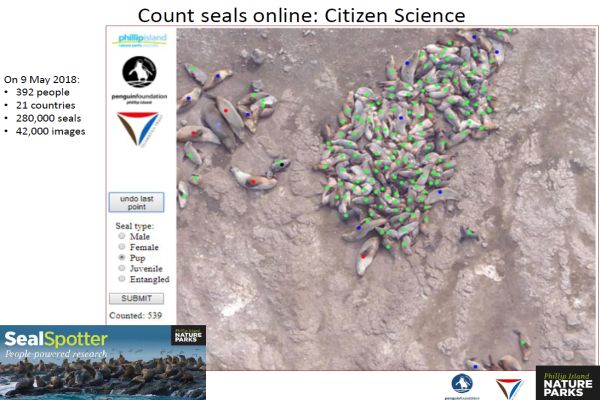
Drones are also used to undertake entanglement counts. Data from the Drone or Remote Piloted Aircraft (RPA) have proven to be far more reliable than actually walking around on at colonies.
Anthropogenic impacts on fur seals
Entanglement – this is an issue recorded at all colonies in Bass Strait with a Seal Rocks near Phillip Island being the worse area for entanglements.
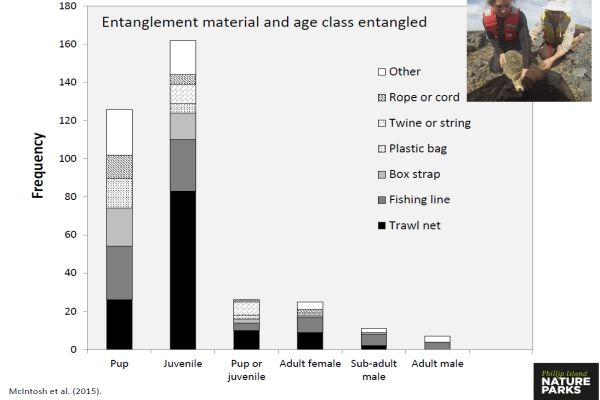
Ingestion of plastics - studies found that 21% of scats from Seal Rocks had microplastics in them and 75% of these were fibres (e.g. from polo fleece).
Bioaccumulation of pollutants – preliminary studies have found persistent organic pollutants may lead to maternal bioaccumulation and transfer to pups. Cases of Alopecia syndrome (hair loss on the back of seals) has been recorded at Lady Julia Percy Island and Seal Rocks. More on this topic; SWIFFT seminar April 2014. Research into Per and Polyfluorinated alkyl compounds in Australian Fur Seal pup livers is on-going.
Climate change – further research needed to assess impacts but increase in pup mortality rates associated with storm surges and dispersal of individuals to higher ground and/or new colonies has been identified as a potential issue.
Actions for conservation of fur seals
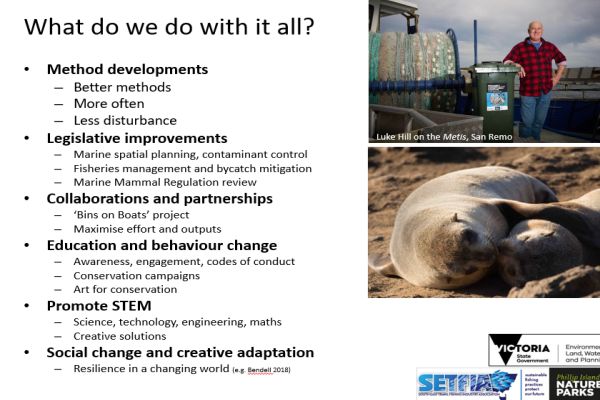
Key points from questions
This session was cut short to one question due to time constraints.
- There is no measure of body condition of breeding adults at present but this is being worked on by using drones to identify body condition for large numbers of animals. Body condition for pups was examined in 2013 with Seal Rocks being the worst colony for pups body condition.
Balancing community values on rays and banjo sharks in our nearshore waters
Dr Jo Klemke, Senior Policy Analyst, Victorian Fisheries Authority
Working with all stakeholders to achieve a shared solution
Jo explained her talk would focus on all species of stingrays, skates and guitarfish which she would refer to as ‘Rays’ for this presentation.
Rays have become a much more prominent and well-known part of Victoria’s marine biodiversity in recent years. For many communities and divers’ rays are regarded as quite charismatic as they have become well known around piers and jetties in Port Phillip Bay.
Rebalancing fishing laws to conserve rays
Jo pointed out there has not been any fishing sustainability issues for any species of rays in Victoria. The program was all about community values and social acceptability.
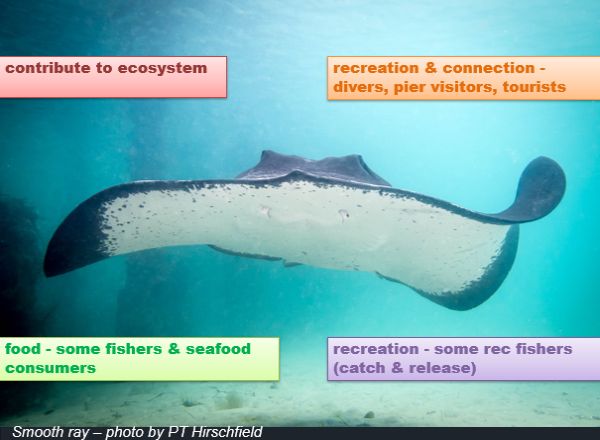
Response to community concerns regarding protection of rays
The issue came to a head in 2017 when the community, through 'Project Banjo Action Group' raised concerns about ray fishing behaviour and the disrespectful treatment of rays by a small proportion of fishers on piers on the Mornington Peninsula.
At the time when questions were being raised about conservation of rays. The Fisheries Legislation provided:
- No minimum or maximum size limit;
- A daily catch limit of 5 (any species) if retained for consumption or used as bait;
- No ray-specific spatial management;
- Unwanted catch must be returned to the water with least possible injury or damage.
The Project Banjo Action Group effectively used social media to lift their profile and request a total ban on ray fishing in Port Phillip Bay. The campaign ‘Stop the senseless slaughter of rays’ was run through change.org which ended up with about 33,000 signatures.
https://www.change.org/p/stop-the-senseless-slaughter-of-rays
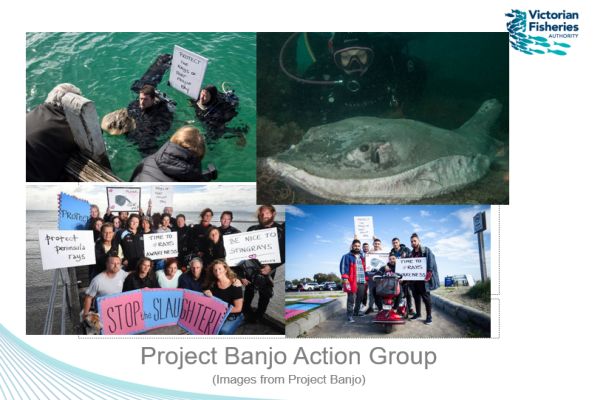
Victorian Fisheries Authority (VFA) response
As it became apparent that existing fishing laws in respect to rays were out of step with community values the VFA engaged with stakeholders and responded with practical actions such as placing signage on piers to inform fishers and the community about responsible fishing. This was extended to the VFA social media platform and other types of media.
A commitment was made to propose reforms to fishing regulations. A Draft Fisheries (Ray Protection) Notice was issued which:
- Prohibited the take and possession of rays less than 1.5m;
- Reduce the daily bag limit to 1 ray;
- Prohibit taking rays within 400m of piers, jetties, breakwaters for recreational fishers.
The public consultation period was 8 weeks.
Community feedback
Jo pointed out there was a lot more feedback and more submissions than would normally happen for Fisheries Notice. VFA received submissions from 1200 different individuals and organisations, comprising locals, around Victoria, other states and international.
Even though ‘Project Banjo’ campaigned for state-wide total ban on the commercial and recreational take of rays, they expressed support for the notice because at the end of the day it was seen as a well shared and agreed solution. Less than 1% of submissions opposed increasing protection for rays.
The engagement process uncovered a fact that there was a small proportion of recreational fishers who would target a ray to keep and eat. Some recreational fishers also enjoy catch and release fishing for rays.
Many recreational fishers were concerned about the disrespectful treatment of rays and reasonable number supported increased protection.
Implementation of new rules
The new rules were implemented November 2017. The rules are very similar to the previous Fisheries Notice which had size, bag and spatial limits. An additional requirement was that rays could only be landed whole or carcass form.
Education & enforcement campaign
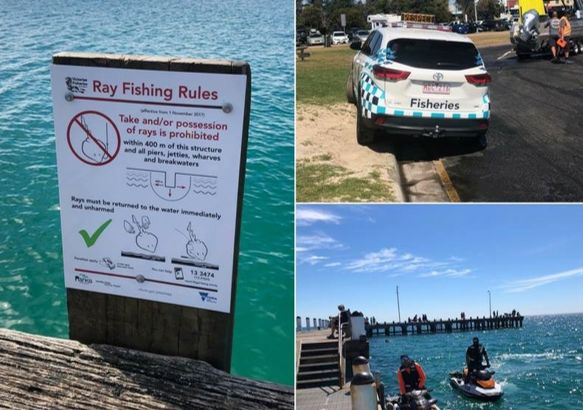
New signs were installed on piers. Circle hooks were given away as an incentive to fish responsibly.
The Fisheries Notice has been renewed a couple of times with consultation and with no opposition. The conservation measures are now in Fisheries Regulations and part of the on-going fishing rules in Victoria.
What was achieved?
- More balanced and socially acceptable ray fishing rules that are well understood and accepted by recreational fishers on piers.
- Respect for ray fishing is now part of an ongoing education to support long term responsible fishing attitudes.
- New and better relationships between stakeholder groups.
- Positive outcomes for fishing and environment stakeholders via increased protection for rays and improved social licence for recreational fishing.
Jo highlighted the fact that ‘Project Banjo’ is a great advocate for the VFA and the outcomes achieved.
In 2017 the project was a Winner - Victorian Coastal Award for planning and management.
Victorian Fisheries Authority - Ray protection fishing rules
Key points from questions
- Possible protection of Giant Spider Crabs aggregations at Blairgowrie is still in an information gathering phase.
Marine biodiversity seminar Notes 24 April 2014


